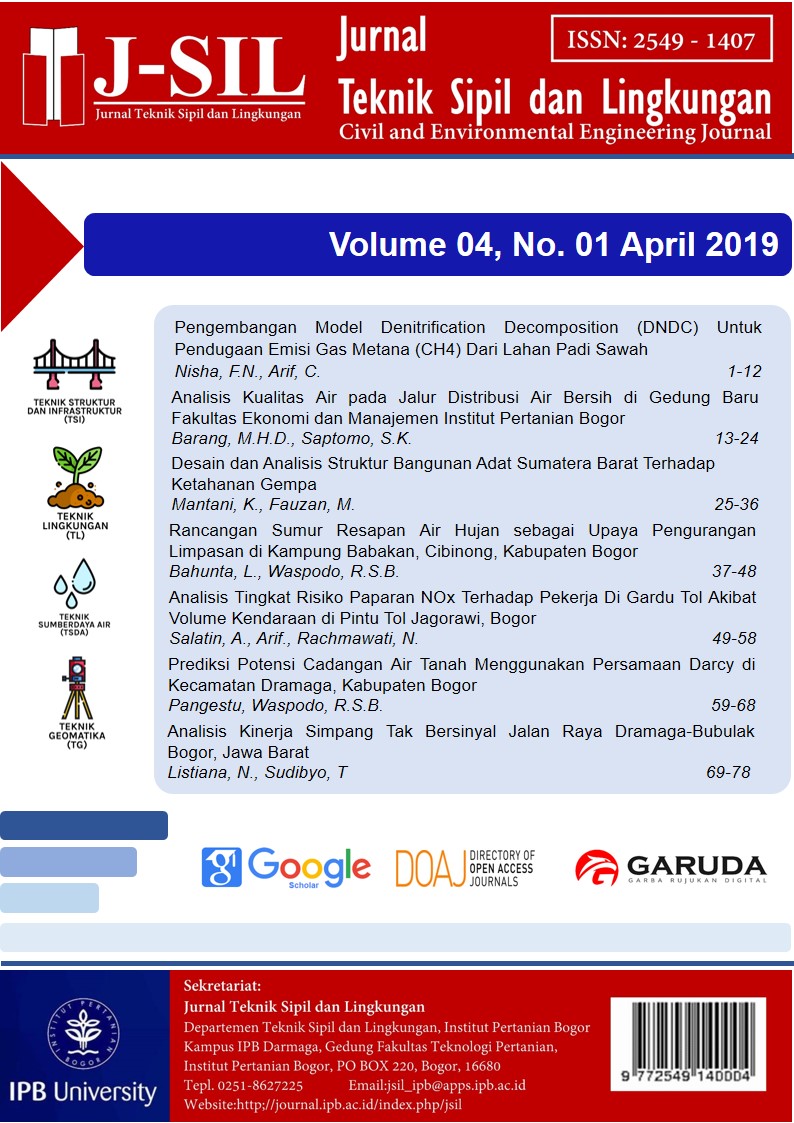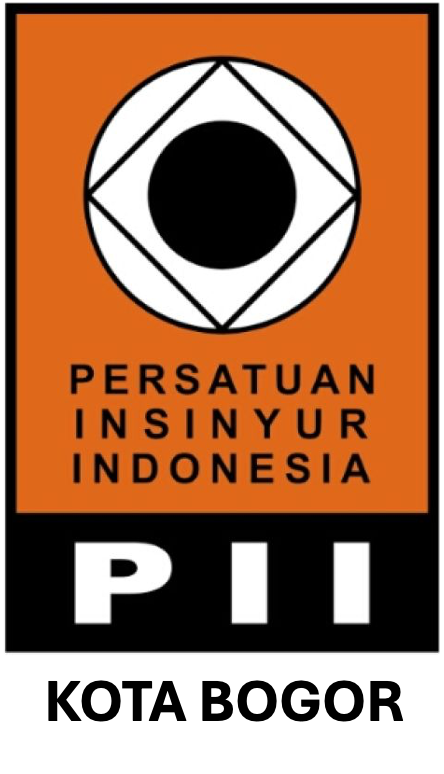Pengembangan Model Denitrification Decomposition (DNDC) Untuk Pendugaan Emisi Gas Metana (CH4) Dari Lahan Padi Sawah
Abstract
Cultivated paddy fields that applied in Indonesia currently produces high emissions of greenhouse gases (GHG), particularly methane gas (CH4). This research aimed to analyze CH4 gas emission in various water management, and to develop DNDC model in predicting CH4 gas emission. This research was conducted from January to May 2018, located at field laboratory of Departement of Civil and Environmental Engineering. The research was conducted by three water regimes i.e., continuously flooded (RT) for conventional rice farming, wet regime (RB), and dry regime (RK) for system of rice intensification (SRI). The highest total methane (CH4) flux was 48.74 kg/ha on RT, on RB was 3.59 kg/ha and on RK -5.40 kg/ha. DNDC model needed data inputs of climate, soil physics, vegetation and anthropogenic activities. The result of the DNDC model showed that the highest total CH4 flux was 44.44 kg/ha on RT, on RB was 17.88 kg/ha and on RK was 0.02 kg/ha. The result, of total actual of CH4 gas flux was compared with DNDC model and got the coefficient of determination (R2) values 0.93, so the model could be used to predict total CH4 gas emission.
Keywords: DNDC, methane gas, paddy field, water regime.
Downloads
References
[IAEA] International Atomic Energy Agency. 1993. Manual on Measurement of Methane and Nitrous Oxide Emission from Agriculture. Vienna (AUT): IAEA.
[IPCC] Intergovernmental Panel on Climate Change. 1990. Climate Change. The Scientific assessment. Cambridge. University Press. Cambridge.
Arif C, Masaru M, Setiawan BI, Ryoici D. 2013. Optimizing Water Management of System of Rice Intensification for Climate Change Adaptation Strategy Based on Field Monitored Data. GRENE 2nd workshop, 4-6 Maret 2013, Baguio, Philippine.
Asri F. 2010. Pengaruh Imbangan Pupuk Organik Dan Pupuk Anorganik Terhadap Emisi Gas Metana (CH4) Di Lahan Sawah Palur [Skripsi]. Surakarta (ID):Universitas Sebelas Maret.
Babu Y, Jagadeesh C, Li S. Frolking DR, Nayak TK, Adhya. 2006. Field validation of DNDC model for methane and nitrous oxide emissions from rice based production systems of India. Nutrient Cycling in Agroecosystems. 74:157- 174.
Dwijayanti Y. Pendugaan Emisi Gas Metana (CH4) pada Berbagai Pengelolaan Tanaman Padi [Skripsi]. Bogor (ID) : Institut Pertanian Bogor.
Hadi A. 2001. Makalah pada Seminar on-Air Bioteknologi untuk Indonesia Abad 21. 1-14 Februari 2001. Sinergy Forum – PPI Tokyo Institute of Technology.
Jonathan LJ, Jonathan DD. 2004. Systemic analysis of bicistronic reporter assay data. Nucleic Acids Research. 32(20):2-10.
Kartohardjono S, Yuliusman, Budhie DS. 2011. Preliminary studies on the selective absorption of CO2 from CH4 through hollow fiber membrane contractor using aqueous extract of noni fruit (morinda citrifolia). International Journal of Technology. 2:147-155
Lelieveld J, Crutzen PJ, Bruhl C. 1992. Climate effects of athmospheric methane. Chemosphere 26 (1-4):739-769.
Li C. 1998. Modeling trace gas emissions from agricultural soils. [abstrak]. Di dalam: IRRI-UNDP Final Workshop; Beijing & Hangzhou, 10-13 August 1998. Beijing & Hangzhou: IRRI. hlm. 15. Abstr no 12.
Neue H. 1993. Methane emission from rice fields: Wetland rice fields may make a major contribution to global warming. Bioscience. 43 (7): 466-73.
Palimbani. 2007. Mengenal Pupuk Urea . Blog Pustaka Negeri WordPress.com dipetik 15 Juli 2018 dari http://pusri.wordpress.com/2007/09/22/mengenal pupuk-urea/.
Setyanto P, Abubakar . 2005. Methane Emission from Paddy Fields as Influenced by Different Water Regimes in Central Java. Indonesian Journal of Agricultural Science. 6:1-9.
Suharsih ST, Makarim AK. 2002. Pengaruh Cara Pengolahan Tanah dan Pengaturan Air Terhadap Emisi Gas Metana Pada Lahan Sawah Irigasi. Prosiding Seminar Nasional Sistem Produksi Tanaman Pangan Berwawasan Lingkungan. Bogor (ID):Pusat Penelitian dan Pengembangan Tanah
Sujono J. 2011. Koefisien Tanaman Padi Sawah pada Sistem Irigasi Hemat Air. Agritech. 31 (4):344-351.
Susandi A. 2004. The Impact of International Greenhouse Gas Emissions Reduction on Indonesia. Report on Earth System Science, Max Planck Institute for Meteorology. Jerman
Authors who publish with Jurnal Teknik Sipil dan Lingkungan, JSIL agree to the following terms:
a. Authors retain copyright and grant the journal right of first publication with the work simultaneously licensed under a Creative Commons Attribution License that allows others to share the work with an acknowledgment of the work's authorship and initial publication in this journal.
b. Authors are able to enter into separate, additional contractual arrangements for the non-exclusive distribution of the journal's published version of the work (e.g., post it to an institutional repository or publish it in a book), with an acknowledgment of its initial publication in this journal.
c. Authors are permitted and encouraged to post their work online (e.g., in institutional repositories or on their website) prior to and during the submission process, as it can lead to productive exchanges, as well as earlier and greater citation of published work (See The Effect of Open Access).











